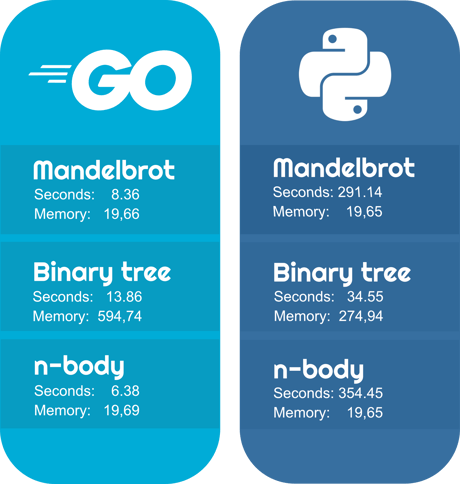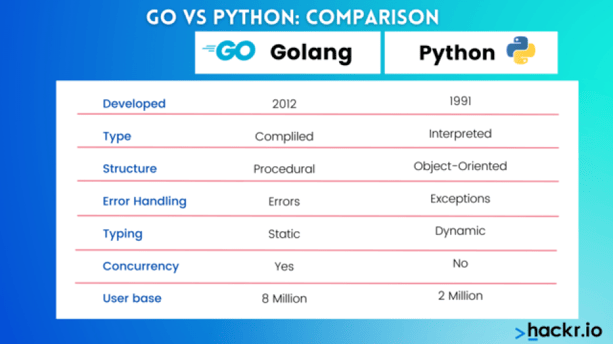If you’re a developer then you’ve probably heard of Golang before, but for those not as knowledgeable in programming it may sound like an ancient city on a lost continent instead of a highly efficient programming language that we love to use for our energy trading software.
So what exactly sets it apart from other programming languages? Golang, also known as Go, offers fast performance and built-in support for handling multiple tasks at the same time, making it great for building efficient and reliable software.
Meanwhile, Python may be easier to learn but does not offer support for parallelism, is significantly slower than Go and uses much more resources. So it’s not much of a surprise that Go is our go-to programming language here, at e*star. To help you further understand, we've summarized our top 4 reasons why we think Go puts you in the driver's seat.
-
1. Unleash A Jaguar: Performance and Speed
-
Energy markets, and therefore prices, are highly volatile thanks to rapid changes to supply and demand, fluctuating weather conditions and geopolitical events. Who can afford to receive data that is not in real-time? Certainly not our customers. This is why we prefer to use Go. Python’s slower execution speed can lead to significantly longer calculation times. While Python would take minutes to solve a problem, Golang only takes seconds for it. We’re talking up to 40 times faster!
In the increasingly competitive market, this is a size ratio that can have a very noticeable effect. It is no longer uncommon for bids to be traded so quickly by algotraders that they can no longer be recognised on the trading screens of human traders. Although we are still a long way from the situation in financial trading, a look at the industry that has revolutionized automated trading suggests that demand for faster trading solutions will also increase in the energy market in the future. A solution that works 40 times faster is undoubtedly an enormous advantage.

2. Built (Go) Tough: Less Performance Degradation & More Compatible with High Data Volume
Like a Ford truck, Go is designed with performance and efficiency as a core principle. It uses lightweight and efficient processes called goroutines to handle tasks simultaneously with nominal memory overhead while the garbage collector also runs with the program, keeping pauses to a minimum and effectively managing memory. While Python runs on a virtual machine, Go compiles directly to native machine code, resulting in faster execution. All of these factors also contribute to Go being able to handle higher amounts of data volume than Python, which can struggle with concurrency limitations, higher memory usage, and slower execution speeds.
3. See the Future in a New Light: Data Forecasting & Future Proofing 
To a certain extent, the future will always be a great, big question mark, but for developers that use Go, this isn’t a scary prospect. Sure, things change fast in the energy market but Go's agile and efficient processing helps software forecast and execute trades quickly. Its ability to perform many tasks at the same time with goroutines makes it great for handling lots of data streams at once.
But Go isn’t just for forecasting - it will also make your trading software more resilient and allows you to quickly adapt to changes in the marketplace. And just like Python, Go has a strong community that can provide support for a wide range of development needs, as well as an ecosystem of libraries and tools.
Because Python is an interpreted language, and therefore has a slower execution speed, it cannot be trusted with data forecasting and future proofing, especially when it comes to the real-time decision making that is necessary in the energy market.
4. The (Programming Language) That Cares: Environmental Benefits
With Go’s concurrency model as well as efficient use of memory, goroutines and effective garbage collector, overall resource consumption is reduced. This means diminished hardware requirements and lower electricity consumption. So not only are you saving money by using Go, but also lowering your emissions!
Meanwhile, Python’s interpreted nature would require more hardware resources, including CPU usage and memory overhead, to achieve the same levels of performance as Go. In turn, this will lead to Python-based energy trading software consuming more electricity to be run and maintained compared to Go.
So if you’re looking for speed, reliability and adaptability in your energy trading software, Golang is the logical first choice. Not only will your trading software be able to handle the dynamic demand of the market quickly and precisely, you will also know that you have chosen the more environmentally friendly programming language. And a little extra cash in your pockets surely doesn’t hurt either.

Still not sure about Go? Let us help you!
Alright, we get it. Go sounds great but who has time nowadays to learn another programming language? Well, if you already know Python then Go definitely is easier to learn. Still, our developers are happy to translate your code from Python to Go so that you can add that extra horsepower to your energy trading experience.
Get in touch and we’ll make sure that your energy trading software is up to speed (and even faster) for today's market.
gopher illustrations created by Ashley Willis under CC BY-NC-SA 4.0
What can we do for you?
Write us and learn about the scalability of our SaaS technology.We are looking forward to your challenge.